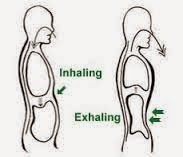In the Ekottara-Agama Sutra, Buddha teaches his son, Rahula. The first question Rahula asks is: "How can I practice anapana in order to get rid of my sadness and worries and be free of all thoughts?"
Straighten out your body and make it correct. Straighten out your mind and make it correct. Straightening out one’s body has to do with putting it in a comfortable position for meditating. Straightening out one’s mind involves breathing. Controlling the bird of thought is a matter of breath. If you cannot get hold of thoughts, they will run in confusion. If you cannot concentrate your thoughts, it is because one’s breath is scattering. When the breath scatters in confusion, then the mind scatters in confusion as well.
The Buddha advises his son “tie your consciousness to your nose.” Imitate the white crane. When the crane stops and rests, its nose faces its anus, and the two breaths circulate together. The phrase “tie your consciousness to your nose” does not mean to observe the nose. It means to pay attention to your breath as you breathe in and out. Make your consciousness follow your breath. Be aware of everything in respect to your breath. How long is the inhalation? How long is the exhalation? Is it a cold exhalation or inhalation? Is it a warm exhalation or inhalation? Observe in full detail as your body breathes in and out, and be aware of it all. The results will be that the power of memory will be very good and your brain will be especially alert.
~ Master Nan Huai-Chin - Adapted from Working Towards Enlightenment
 |
| Belly Action in the Breathing Cycle |
JJ Semple in his book Deciphering The Golden Flower One Secret At A Time, writes:
“Observing my breath as I sit one morning, I am aware that it has the property of direction. At each inhalation the hitherto imperceptible wind in my belly appears to eddy slightly at the bottom of my abdomen as it descends before taking an upward circular course. Or so it appears to me: Down the back, then up the front, in a circular motion. Something clicks. I remember the words ‘backward-flowing method’ in The Secret of the Golden Flower, words I’ve passed over a hundred times, never having a clue as to what they meant, never imagining they might be important. I break off to look for the passage. In two quick flips, I‘ve located the text: “At this time one works at the energy with the purpose of making it flow backward and rise, flow down to fall like the upward spinning of the sun-wheel…in this way one succeeds in bringing the true energy to its original place. This is the backward-flowing method.”
This is a good example of “tying ones consciousness to the breath.” In fact, by the mind alone, (by directing one's intention) consciousness can change the direction of the breath to facilitate the rise of Kundalini and the opening the energy channels as explained in JJ Semple's book.
My own beginning experience with kundalini is a little different but had the same result. During a period of intense meditation, I suddenly became aware of a spontaneous change in my breathing patterns. It started with deep inhaling and holding, and then a release of breath. It was as if the breath from the pressured inhale was being directed towards various areas of my body, particularly the diaphragm, to open up these places previously devoid of air flow.
A short time later, I began to notice further changes. I became conscious of my breath rotating in a circular fashion in the abdomen area. I felt compelled to encourage this circular flow of breathing as it gave rise to bliss and a sense of being moved deeper into meditative absorption. Along with this change in breathing pattern, in my mind’s eye I visualized a wheel rotating in the same direction with my breath. It was as if my consciousness and breath were working together to keep this wheel turning in a smooth consistent rotation.
This is another example of “tying consciousness to the breath." Both cases, cited above, resulted in the rise of Kundalini and the opening of the energy channels and chakras.
Dhyana is a Sanskrit word which means an absorption into a state of mind brought about by meditation. In particular, dhyana refers to the four stages of absorption, sometimes called the "four dhyanas."
Anapana, or “tying consciousness to the breath,” is the beginning of the first stage of dhyana. It is a cultivation practice that begins the process of eliminating worries, vexations, and confused thoughts as one develops an inward awareness of all that is happening in the body and a concentration centered on the breath.
In a future post, I will give a brief explanation of the four stages of dhyana as described by Master Nan Huai-Chin in his book Working Towards Enlightenment.




No comments:
Post a Comment